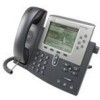Cisco 7962G Administration Guide - Page 111
Configuring Corporate Directories, Modifying Phone Button Templates
 |
UPC - 882658140341
View all Cisco 7962G manuals
Add to My Manuals
Save this manual to your list of manuals |
Page 111 highlights
Chapter 5 Configuring Features, Templates, Services, and Users Modifying Phone Button Templates To support this feature, you must configure corporate directories. See the "Configuring Corporate Directories" section on page 5-13 for more information. • Personal Directory-Allows a user to store a set of personal numbers. To support this feature, you must provide the user with software to configure the personal directory. See the "Configuring Personal Directory" section on page 5-13 for more information. Configuring Corporate Directories Cisco Unified Communications Manager uses a Lightweight Directory Access Protocol (LDAP) directory to store authentication and authorization information about users of Cisco Unified Communications Manager applications that interface with Cisco Unified Communications Manager. Authentication establishes the users' rights to access the system. Authorization identifies the telephony resources that a user is permitted to use, such as a specific telephone extension. For more information, refer to the "LDAP System," "LDAP Directory," and "LDAP Authentication" chapters in the Cisco Unified Communications Administration Guide. After the LDAP directory configuration completes, users can use the Corporate Directory service on their Cisco Unified IP Phone 7962G and 7942G to look up users in the corporate directory. Configuring Personal Directory Personal Directory consists of the following features: • Personal Address Book (PAB) • Personal Fast Dials (Fast Dials) • Address Book Synchronization Tool (TABSynch) Users can access Personal Directory features by these methods: • From a web browser-Users can access the PAB and Fast Dials features from the Cisco Unified Communications Manager User Options web pages • From the Cisco Unified IP Phone-Users can choose Directories > Personal Directory to access the PAB and Fast Dials features from their phones • From a Microsoft Windows application-Users can use the TABSynch tool to synchronize their PABs with Microsoft Outlook. To configure Personal Directory from a web browsers, users must access their User Options web pages. You must provide users with a URL and login information. To synchronize with Microsoft Outlook, users must install the TABSynch utility, provided by you. To obtain the TABSynch software to distribute to users, choose Application > Plugins from Cisco Unified Communications Manager Administration, then locate and click Cisco IP Phone Address Book Synchronizer. Modifying Phone Button Templates Phone button templates let you assign speed dials and features to programmable line buttons. While both SCCP and SIP phones support speed dial buttons, support for call features on buttons depends on the call control protocol: OL-14625-01 Cisco Unified IP Phone 7962G and 7942G Administration Guide for Cisco Unified Communications Manager 6.1 5-13















